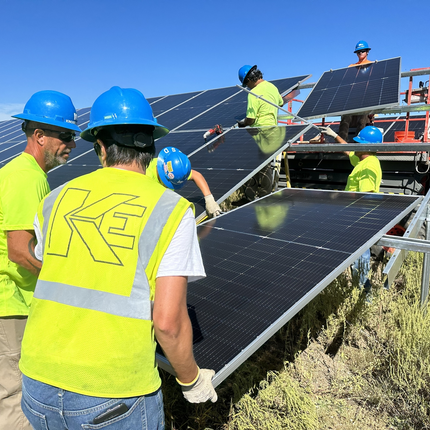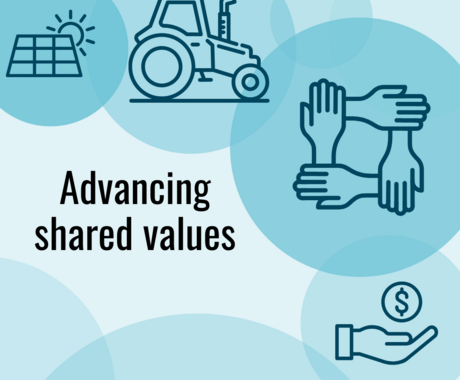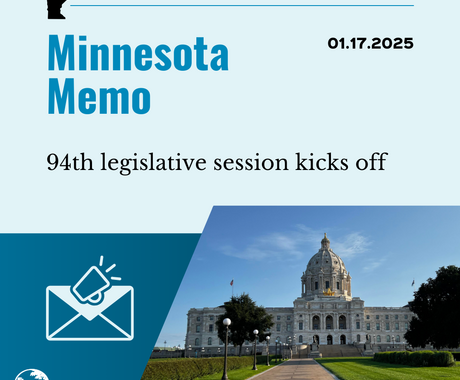For the Prairie Island Indian Community, taking advantage of renewable energy is a way to preserve its way of life for future generations.
Tribal leaders have been interested in the opportunities renewable energy could bring the community for several years, and in 2020 they moved from interest to action by becoming one of the first Tribal Nations to set a goal to achieve net zero carbon emissions.
Two years earlier, community leaders approached the Minnesota Legislature with a request for funding from the state’s Renewable Development Account (RDA). The account was established in 1999 as a condition of allowing Xcel Energy to temporarily store nuclear waste in dry casks outside its power plant, which is adjacent to the Tribe’s reservation. RDA funds were previously only available to Xcel Energy customers, and the Prairie Island Indian Community was not one.
Their request received broad bipartisan support but was included in a bigger bill that Gov. Tim Walz eventually vetoed. The project was brought back in 2019 and was again broadly supported, but the Legislature was at a standstill and nothing passed. The Tribe's effort was finally rewarded in 2020 when a widely supported bill was passed and signed into law.
Following the 2020 session, the Tribal Nation was awarded $46 million from the RDA to support its Net Zero Project. The project embodies Prairie Island’s goal to eliminate or offset carbon emissions produced across the community through efforts such as renewable energy generation and electrification.
“It’s also a way to embody Dakota (people) values which go back many generations,” said Andrea Zimmerman, energy program manager. “A core value for Tribal leaders and members is creating balance with Mother Earth and having a sustainable world for the next seven generations.”
Using a comprehensive approach for renewable energy projects, Prairie Island seeks ways to pursue the net zero vision while also supporting their community. They are installing a 5.4 megawatt ground-mounted solar field that will finish in early 2024. It will deliver renewable energy to the local electric grid that serves the Tribal Nation and surrounding community.
The largest carbon reduction will come from a commercial scale geothermal electrification project they hope to finish mid-2025. The project will help them move away from using natural gas at Treasure Island Resort & Casino, which is owned by Prairie Island.
Additionally, the Tribal Nation has several smaller projects in the works, including trading in gas-powered vehicles used by government staff and at the resort and casino for electric shuttles and buses. They are also working with community members to identify simple, inexpensive ways to save energy and money in their homes.
The Prairie Island Indian Community recognizes the work they have done is largely due to the incredible efforts of its Tribal members who helped set the vision and goals, provided input on projects, and helped in construction of the solar field this past summer.
Andrea also acknowledges the “excellent partners, including tribal-owned and local organizations, who have been an essential support to Prairie Island’s net zero efforts and have helped us navigate unique challenges.” These partners have helped lay the groundwork for a Tribal energy system that will result in net zero emissions.
The Tribal Nation has found “tremendous opportunities through both state and federal policies,” Andrea said.
At the federal level, both the Inflation Reduction Act and Bipartisan Infrastructure Law helped provide the necessary funding to support Prairie Island’s clean energy projects. Announced this year, the Nation will receive $1.1 million through the Bipartisan Infrastructure Law to build a transportation maintenance facility, which will improve and support sustainable transportation solutions.
At the state level, Minnesota passed a law earlier this year requiring utilities to use only carbon-free sources to generate electricity by 2040.
“The law has helped utilities and the market to continue shifting in this direction, with an even clearer path and deadline now, ” Andrea said. “Changes at the state and federal level have opened many new grant programs, cost matching, and technical assistance opportunities that the Tribe is exploring.”
As with other communities, one of Prairie Island's biggest challenges is being able to take advantage of the funding opportunities, given time and staffing restraints.
Andrea hopes other Tribal Nations will follow their lead in setting a net zero carbon emission goal.
“We would be excited to see others do the same,” Andrea said. “We have an exciting vision set and a community-wide effort that Prairie Island is putting forward to achieve our goal.”
To learn more about the Prairie Island Indian Community and the Net Zero Project, visit their website.





